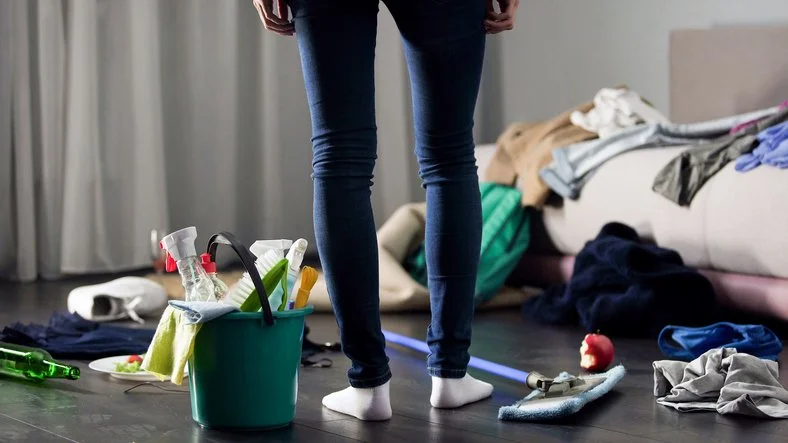Understanding Hoarding: The Trauma Behind Clutter
(Because sometimes it’s not just about stuff—it’s about survival).
By: Joy Stephenson-Laws, Holistic Coach, J.D., Founder
If you’ve ever stood in a room filled with clutter and felt paralyzed, overwhelmed, or ashamed—you’re not alone. And you’re not broken.
Hoarding and chronic disorganization are not signs of laziness or lack of discipline.
They’re often somatic echoes of trauma, shaped by the body and nervous system’s attempt to feel safe, anchored, or in control.
Let’s unpack what your “mess” might really be saying—and how healing can begin.
1. More Than Just “Too Much Stuff”
Hoarding isn’t just about collecting items. It’s about what those items represent:
Memories
Safety
Identity
Proof of worth
Insurance against future loss
For trauma survivors, especially those who experienced childhood instability, neglect, or emotional deprivation, stuff becomes a stand-in for what was missing:
“I wasn’t allowed to have nice things—now I keep everything.”
“If I let it go, I’ll lose something important.”
“I don’t trust I’ll have what I need next time.”
Research shows that hoarding often stems from scarcity-based trauma, including wartime loss, emotional neglect, or forced displacement.
2. Disorganization as a Nervous System Response
Trauma affects the prefrontal cortex—the part of your brain responsible for executive function: planning, sorting, decision-making, and impulse control. When that function is disrupted, even simple tasks become overwhelming.
Psychology Today explains how trauma impairs cognitive functioning, making organization and task initiation feel neurologically exhausting.
You’re not lazy. You’re overloaded.
3. Clutter and the Freeze Response
While some people fight or flee under stress, others freeze—they shut down, numb out, or disassociate. In a freeze state:
Dishes pile up
Mail goes unopened
Rooms become storage zones
Days blur together
NICABM highlights how the freeze and shutdown responses affect physical energy, spatial awareness, and focus—perfect conditions for disorganization to take root.
4. Letting Go Feels Like Losing Control
Decluttering might sound simple—until you try it. For trauma survivors, letting go of objects can feel like:
Reliving past losses
Facing scarcity
Losing identity
Making irreversible mistakes
That’s why many trauma-informed therapists and organizers recommend ritualizing the release process:
Say goodbye
Thank the item
Acknowledge the meaning it once held
Because it was never just “junk.”
5. “I Might Need It Someday” = I’ve Lived Without Safety
The compulsion to save things “just in case” is often rooted in scarcity conditioning, which is often formed in early trauma or chronic stress environments.
According to the Harvard Center on the Developing Child, early adversity and unpredictability alter a person’s sense of security and can lead to hoarding and over-preparing behaviors later in life.
6. Healing Starts with Safety, Not Storage Solutions
Before you can organize your space, you have to regulate your nervous system. Here’s how to begin gently:
a. Start Small (Really Small)
Don’t organize the whole room. Choose one drawer. One surface. Even one object.
b. Notice the Story
Ask: “What does this item represent?” instead of “Why am I keeping this?”
c. Create a Safe Ritual for Letting Go
Burn sage. Light a candle. Write a goodbye note. Make it meaningful.
d. Regulate Before You Declutter
Try breathwork, grounding, or even music that makes you feel strong and calm before you start.
e. Work with a Trauma-Informed Organizer or Therapist
Yes—they exist. And yes—they’re amazing. The Life Edit Project offers excellent resources for somatic approaches to decluttering.
7. When the Clutter Mirrors the Chaos
Sometimes your outer space reflects your inner world.
But here’s the good news: changing one changes the other.
When you clear a drawer, you might clear a long-held belief.
When you make room in a closet, you make room in your heart.
When you learn it’s safe to let go—you begin to live with less fear.
Final Thought: Your Mess Is Not a Moral Failure
It’s a message.
It says: “Something happened. I tried to cope. And this is what helped me feel okay—until now.”
You don’t have to shame yourself into cleaning.
You can love yourself into healing.
One object, one breath, one corner at a time.
References
Koslowitz, R. (2025, January 21). Maybe you’re not lazy. Maybe it’s a trauma response. Psychology Today. Retrieved from https://www.psychologytoday.com/us/blog/targeted-parenting/202501/maybe-youre-not-lazy-maybe-its-a-trauma-response
Burnside, A. (2021, April 19). The interior lives of hoarders. The Atlantic. Retrieved from https://www.theatlantic.com/culture/archive/2021/04/hoarding-ae-reality-tv-kate-durbin-poetry/618610/ theatlantic.com
National Institute for the Clinical Application of Behavioral Medicine. (n.d.). How to overcome the freeze response. NICABM. Retrieved June 9, 2025, from https://www.nicabm.com/topic/freeze/
Mullainathan, S., & Shafir, E. (2013). Scarcity: Why having too little means so much. Times Books. Retrieved from https://www.hks.harvard.edu/centers/cid/
Burrows, E. (n.d.). Somatic organizing. In The Life Edit Project. Retrieved June 9, 2025, from https://lifeeditproject.com/






